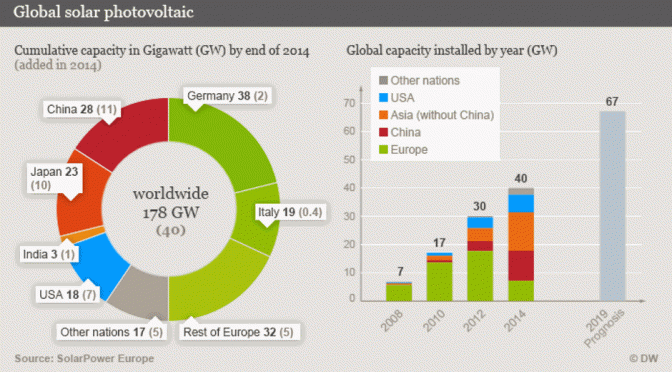Solar power now covers more than 1% of global electricity demand. In three countries in Europe – Italy, Germany and Greece – solar PV supplies more than 7% of electricity demand. This is reported by Solar Power Europe (previously EPIA – European Photovoltaic Industry Association). China is the fastest growing market. Research company GlobalData has adjusted projected new capacity in China for 2015 upwards.
Last year 40 GW of new solar capacity was installed worldwide, compared to 38.4 GW in 2013, notes Solar Power Europe (SPE) in its Global Market Outlook 2015-2019.
Cumulative capacity is now 178 GW. In terms of generation, this is equivalent to 33 coal-fired power stations of 1 GW, notes SPE. In Europe last year 7 GW was installed, which was less than in 2013. The UK was the fastest growing market, contributing 2.4 GW. Europe now installs less solar power capacity than China or Japan individually, but still more than the US. However, Europe is still the world’s largest playher with more than 88 GW installed at the end of 2014.
China is currently the fastest growing market, installing 10.6 GW in 2014, followed by Japan with 9.7 GW and the US with just over 6.5 GW. SPE says capacity could reach 540 GW in five years’ time in a high-growth scenario and would reach 396 GW in a “low-support” case.
The cost of PV systems continued to decline in 2014, notes SPE. “System prices below €1/wp are now common in several European countries, while prices around $1/wp have been reported in the most competitive tenders. This has been achieved thanks to the declining prices of modules – except in Europe where the minimum import price on modules from China has maintained prices at a higher than market level – and inverters, combined with economies of scale that brought installation costs down much faster than many expected.”
SPE notes that PV power prices below $60/MWh have been granted in one project in Dubai, which remains to be proven to be profitable. Other calls revealed prices between $67 and $80 per MWh. These should be considered “as best in class examples for the solar generation cost within a favourable context”. Cost of capital is one of the main barriers to the decrease of solar electricity cost, according to SPE.
Meanwhile market researchers GlobalData have come out with a new report which projects that 17.6 GW of new solar PV will be installed in China in 2015, i.e. an increase of some 7 GW. GlobalData notes that “For 2015, the country had previously set a target of making 15 GW of solar PV additions, comprising 7 GW of distributed generation and 8 GW of ground-mounted capacity. However, China has revised its annual target to 17.8 GW and is well on track to achieve this goal, given that about 5 GW of solar capacity was installed in Q1. These additions will allow the country to retain its world-leading status for annual solar PV additions.”
GlobalData’s report also states that the US is likely to become the second largest market in 2015. Japan will slip to third, with the country expected to see a decrease in its annual solar PV installations following two years of impressive growth.
“In the US, annual installations are expected to remain high during 2015 and 2016 owing to tax incentives for power stations that come online before the end of 2016. Solar additions in 2015 are expected to hit 7–8 GW, largely due to continued policy support.”
“Japan’s lucrative solar PV policies have been attracting an increasing amount of investment since 2012, with annual installed capacity in 2014 reaching 8–9 GW, the country’s highest ever installed capacity in a single year. However, annual installations in 2015 are unlikely to reach 2014 levels.”
Completing the top five markets will be Germany, which will increase solar PV installations by 2 GW in 2015, and India, which will add between 1.5–2 GW, according to GlobalData.



